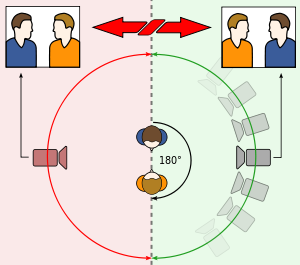
orienting the audience.
The 180° rule is a basic guideline in film making that states that two characters (or other elements) in the same scene should always have the same left/right relationship to each other.
Match on Action:
Connects two shots cut together by having a character finish an action in the second shot that begun in the first shot (making sequence flow, action is fluid). For instance, if a character lights a match in the first shot, the same character will draw it up to a cigarette in the second.
A process of cutting a sequence of the same action together to make it appear seamless. A technique used in continuity editing.
Continuity Editing:
An editing style that aims to present the text in a linear and chronological manner to emphasize the real-time movement of the narrative and to create a sense of realism for the viewer by giving the impression of continuous filming.
Referred to as invisible editing, so that the whole sequence looks natural.
Shot reverse shot:
Shot reverse shot (or shot/countershot) is a film technique where one character is shown looking at another character (often off-screen), and then the other character is shown looking back at the first character. Since the characters are shown facing in opposite directions, the viewer assumes that they are looking at each other.
(not necessrily dialogue)
Eye-line match:
cut to an object, then to a person. This technique shows what a person seems to be looking at and can reveal a character’s thoughts.
shots are matched by the linkage from the gaze of one character towards another character. If character A looks down to see character B, character B will look up to see character A.
A cut between a character looking at something and the something at which the character gazes. For instance, a telephone rings and we see a character glance off screen. The next shot is of the telephone.
No comments:
Post a Comment